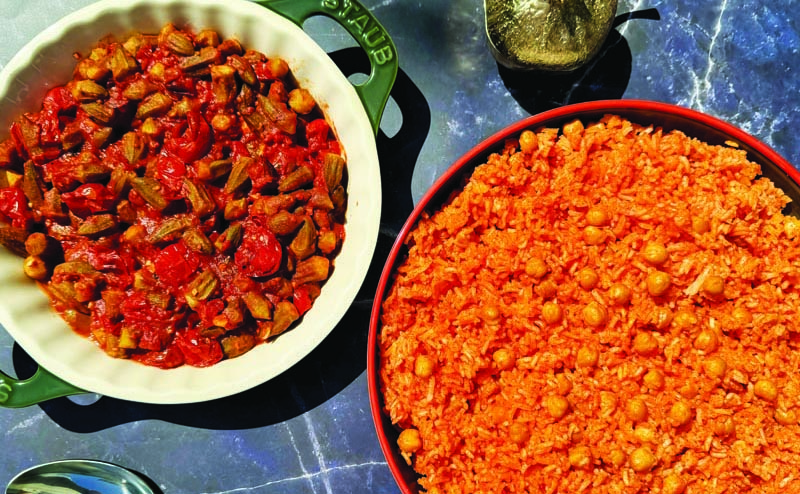
About 15 years ago, I was on a visit to Israel and staying at my aunt Daisy’s home in Ramat Gan. On motzai Shabbat (Saturday night), there was a gentle knock at the door. I went to open the door with Shevy, my 18-month-old daughter, in my arms. I greeted my father’s youngest brother Aryeh with a big smile. He wordlessly reached out to take Shevy and she gladly went into his arms.
Shevy sat contented on my uncle Aryeh’s lap for three hours, while he fed her fruit and cookies. My cousins and I told stories and we laughed a lot. We cracked sunflower seeds, drank hot cardamom tea and m’ei soda (seltzer) and indulged in my Aunt Daisy’s delicious baba tamar (date cookies). It was the perfect way to spend a Saturday night.
As he was leaving, my uncle handed Shevy back to me and said “You have no idea how happy you made me tonight!”
Those were the last words we ever spoke, because he passed away a little over a year later.
This past weekend was the bar mitzvah celebration of my nephew, Eitan Lavi. My brother Danny and his beautiful wife Lemor named their second son in honor of our uncle Aryeh. “Aryeh” means lion, “Eitan” means strong and “lavi” means baby lion. My kind, quiet, gentle and intelligent nephew Eitan Lavi reminds me so much of my beloved uncle.
There is no Jewish celebration without food and this bar mitzvah was no different. There were trays of Bibi’s muffins, Starbuck’s coffee and juice for the Thursday morning prayers. There was a catered Shabbat lunch after a flawless Torah reading at Chabad of Sola. And for the Sunday night party, my incredibly talented cousin Daniella Wolf (@eventsbyella2) worked her magic. She served up yummy pulled beef sandwiches and fries, a Mexican station with handcrafted tacos, and an Israeli style shawarma and falafel bar!
But Friday night was a family affair. Of course, I offered to cook some of the meal, which gave me the opportunity to test Rosh Hashanah recipes for you, dear reader. Along with our family favorite shepherd’s pie, I served brisket, barbecued chicken, roasted sweet potatoes and delicata squash, sautéed white and baby bella mushrooms and a fabulous broccolini dish.
The homemade desserts included a rich chocolate torte and a huge pavlova topped with parve whipped cream, cut strawberries, blueberries, blackberries, raspberries and a generous amount of passionfruit.
In his bar mitzvah speech, Eitan thanked me for all the meals I’ve cooked and for all the meals I will cook and for showing him what it means to be a family. What more can I ask for?
—Sharon
Our sincerest wishes for a sweet, happy, healthy, and most peaceful New Year! May your cooking adventures be ever delicious and delightful and may
you be surrounded by the warmth of friends and family. L’Shana Tova U’Metuka! Rachel and Sharon
This caramelized date brisket is our favorite type of recipe—easy to make, but sophisticated in presentation and mouthwatering to eat. In this recipe, the brown sugar works as a natural tenderizer, blending with the dates, cinnamon and paprika for a wonderful smoky, caramelized flavor, contrasting with the tangy notes of the canned tomatoes and citrusy sumac.
Caramelized Date Brisket
Marinade
1/4 cup brown sugar
2 tsp kosher salt
1 tsp ground black pepper
2 tsp granulated garlic powder
2 tsp paprika
1 tsp sumac
1 tsp cinnamon
1/3 cup extra virgin olive oil
1 cup water
Mix the sugar, salt, pepper, garlic powder, paprika, sumac, cinnamon and olive oil into a paste. Add water and stir until the paste has a uniform consistency. Set aside.
1 3-4lb beef brisket or chuck roast, washed and patted dry
1 14 oz can of whole tomatoes
1 large red onion, peeled and cut into wedges
6 large medjool dates, quartered
Preheat oven to 350°F.
Place brisket in an oven proof dish. Layer onion around the brisket. Cut the canned tomatoes in half and place around the brisket, then pour the remaining tomato sauce over the brisket. Layer dates on top.
Spoon the marinade over the beef and cover tightly.
Bake in the oven for one hour, reduce heat to 300°F and bake for three hours more.
Remove from oven and allow to cool. Slice and cover with juices. Reheat for at least 30 to 45 minutes before serving.
—Sharon

Photo by Sephardic Spice Girls
Many years ago, Sharon and I posted a bamia (okra) stew on our Sephardic Spice SEC Food Facebook page. Rene, the Egyptian-born mother of our friend Molly, was not happy. She responded in the comments in all caps. “YOUR BAMIA IS TOO BIG!! COME TO MY HOUSE AND I’LL SHOW YOU HOW IT’S MEANT TO BE COOKED!”
The Moroccan kitchen doesn’t include okra, which I find strange because it is so popular throughout the Middle East and the Mediterranean. I was introduced to okra by my Rhodesli husband, who absolutely adores it. When he was a little boy, his mother and grandmother would actually serve him bamia sandwiches.
Okra has the power to connect people. My husband is an immigration attorney so whenever he has a Muslim or Christian client from the Middle East, talking about bamia is a sure icebreaker. Right away. “How do you make it?” “For sure, it has to be small, not large.” At which point, one of them will stick out their index finger and show the correct measurement. Everyone has an opinion on the correct size!
Once Neil and I were driving in a taxi in Istanbul. Neil was describing to the driver all the foods of Turkish origin that we cook. When he mentioned bamia, well, that was all he had to say. The driver lit up and we became the best of friends.
I have to admit that when I first tried it, I didn’t love it because it was slimy. Okra is one of those foods that you either love or absolutely detest. (It helps to be introduced to it in childhood.) For many years, I would cook it but not really eat it, just tasting it to make sure the sauce was lemony enough. Then, a few years ago, at the LA Persian kosher markets, I discovered frozen baby okra. It’s soft and tender and delicate in flavor and I became a fan of this healthy vegetable.
—Rachel
Bamia
Okra with roasted tomatoes
Okra season in Southern California comes from midsummer until October. (Luckily, frozen baby okra is available all year long.) The key to success is selecting smaller size okras that have less moisture content and fewer seeds.
1 pound fresh okra or 1 bag frozen baby okra, defrosted
2 14oz cans cherry tomatoes
2 garlic cloves, finely chopped
1 Tbsp olive oil
1 tsp oregano
1/2 tsp salt
Juice and zest of 1 lemon
Garnish— a drizzle of olive oil
Preheat oven to 350°F.
In a medium bowl, combine tomatoes, garlic, oregano and salt.
Place in an ovenproof dish and bake for 45 minutes.
Remove from the oven and add the okra, then cover with foil.
Bake for 30 minutes, then remove foil and bake for 10 more minutes.
Remove from oven and taste for seasoning and add salt, if needed.
Finish with lemon juice, lemon zest and a drizzle of olive oil.
Rice is a staple in the Sephardic kitchen and you will always find it on my menu. The favored Sephardic rice is a Spanish-style recipe of a white rice cooked with fresh tomatoes or tomato sauce.
My mother always prepared a paella-style tomato rice with added vegetables or a saffron yellow rice. My mother used jasmine rice, which has a wonderful comforting flavor that I still love. But Neil will only eat Mahatma brand rice. When I married Neil, I learned to make his mother’s Rhodesli red rice. It was not a complicated recipe—a plain long grain white rice simmered with a tomato sauce. But I worked hard to perfect it. The rice had to be uno por uno, one by one. Meaning each grain of rice is perfectly cooked and not sticky.
My mother-in-law would jazz up her basic tomato rice for special occasions and holidays by adding garbanzo beans. It’s actually a really nice and unexpected addition that makes the dish a little more interesting. It’s also a great source of protein, a plus for any vegetarians or vegans at your table.
Arroz con garbanzos
Rice with chickpeas
2 cups long grain rice
1/4 cup avocado or olive oil
1 14oz can tomato sauce
1 1/2 cups water
2 tsp salt
1 14 oz can garbanzo beans, drained and rinsed
In a medium bowl, soak the rice in cold water for 15 minutes. Then rinse the rice until the water runs clear.
Simmer the oil and tomato sauce in a large pot. Add water, salt and rice, stirring well. Bring to a boil, then add the garbanzo beans and stir with a fork.
Reduce heat to a simmer and when the water has evaporated, cover the with a tightly fitted lid. Cook for another 15 to 20 minutes, stirring occasionally.
When rice is cooked, turn off the flame. Place a paper towel on top of the pot and cover with the lid, to keep the rice moist.
On a recent trip to Manhattan, we scored a hard-to-get reservation at Malka, kosher restaurant on the upper west side, owned by the famed Israeli chef Eyal Shani. Among the delectable dishes we ate was his incredible broccolini on a bed of horseradish aioli. This is my interpretation of the recipe and I promise it’s a real winner!
—Sharon
Broccolini with Horseradish Aïoli
1/3 cup mayonnaise
1 Tbsp white horseradish
1 Tbsp white wine vinegar
2 Tbsp olive oil
2 Tbsp water
1- 1/2 lbs broccolini, washed and cut into thin stalks
1/2 tsp kosher salt
In a small bowl, combine mayonnaise, horseradish and vinegar. Set aside.
In a large skillet, warm olive oil and water over medium heat.
Add the broccolini and simmer for 3-5 minutes, until broccolini is bright green and fork tender.
Just before serving, spread aioli on a serving dish and place warm broccolini on top.
Sharon Gomperts and Rachel Emquies Sheff have been friends since high school. The Sephardic Spice Girls project has grown from their collaboration on events for the Sephardic Educational Center in Jerusalem. Follow them
on Instagram @sephardicspicegirls and on Facebook at Sephardic Spice SEC Food. Website sephardicspicegirls.com/full-recipes.


































 More news and opinions than at a Shabbat dinner, right in your inbox.
More news and opinions than at a Shabbat dinner, right in your inbox.